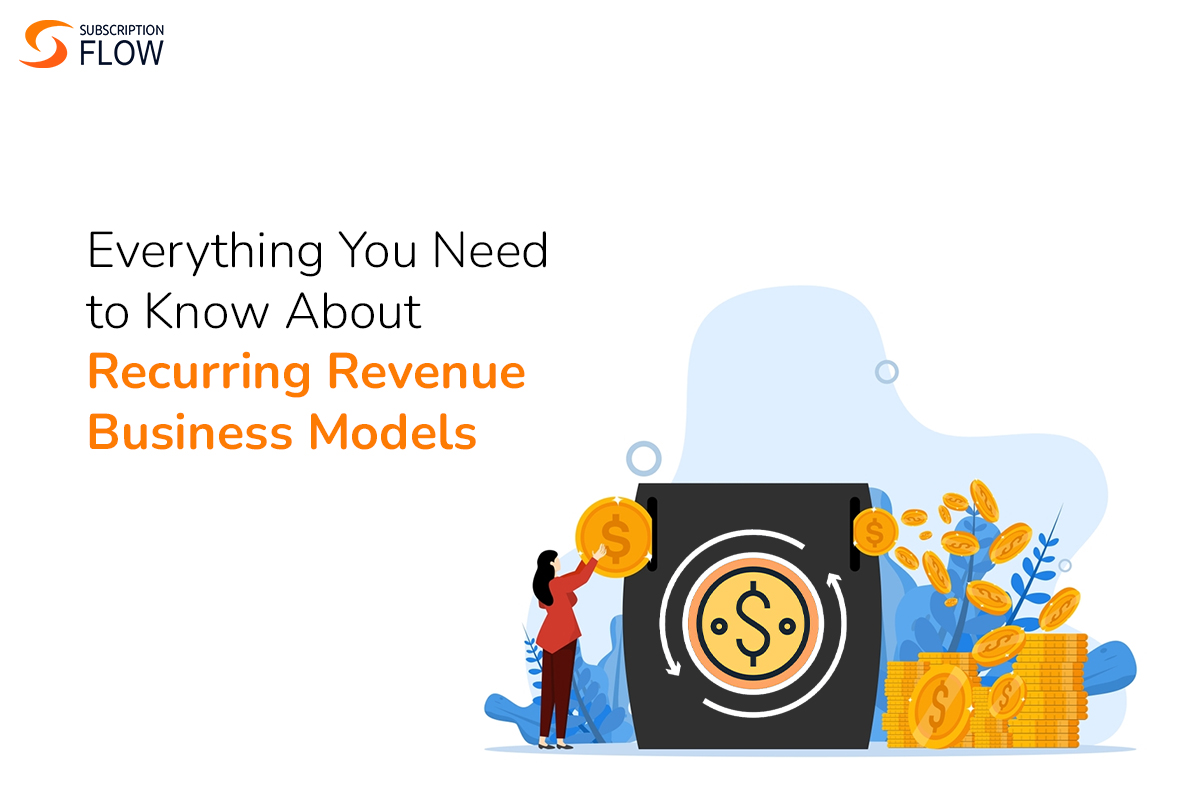
A Guide to Recurring Revenue Business Models
Recurring revenue business models have become all the rage in the current business climate, as companies across industries eagerly strategize how to harness the immense potential of this lucrative, predictable, and scalable revenue model.
In this blog post, we will break down everything you need to know about the recurring revenue business model, the reasons behind its mass popularity, its different types alongside some case studies on businesses that have done it right.
What is Recurring Revenue?
Recurring revenue, as the name implies, is the income businesses generate from subscriptions or memberships that are charged regularly, on a weekly, monthly, or yearly basis.
It is income generated by an ongoing sale of products and/or services that stems from a one-time sales decision, followed by repeat transactions until the customer cancels or suspends their subscription. This type of revenue is highly desirable because it is steady, predictable, and can be scaled up over time.
How is Recurring Revenue Quantified?
Broadly speaking, recurring revenue is quantified in the following three core metrics:
1. Monthly Recurring Revenue (MRR)
MRR represents the aggregate monthly revenue derived solely from recurring sources, encompassing monthly subscription payments, annual contract payments renewing within the same period, and any supplementary recurring revenue streams like add-ons and cross-sells. Revenue from one-off sales during this period are not included in this calculation.
Read More: What is MRR, And Why Is It Inevitable for Measuring Recurring Revenue for Subscription Businesses?
2. Annual Recurring Revenue (ARR)
ARR, as the name suggests is like MRR, but calculated on an annual basis. It represents the total predictable revenue generated from recurring sources over a year. ARR provides a longer-term view of your recurring revenue performance and is useful for measuring annual growth rates.
3. Quarterly Recurring Revenue (QRR)
QRR is the revenue generated in a quarter or 3-month period to track growth rates. Quarterly reports are useful in dynamically tracking and reporting revenue growth trends.
The Benefits of Recurring Revenue
The recurring revenue model has enjoyed endless popularity for the simple reason that it benefits everyone involved.
For Customers:
With subscriptions the cost of the product/service is spread out over a long period of time and a greater pool of customers now have the purchasing power to access your offering.
For example, in the case of SaaS companies, many customers, especially in the B2C scenario, may struggle to pay heavy upfront costs to purchase software in one go and would also not benefit from future updates.
Breaking down the payment and giving customers continuous and hassle-free access to a dynamic, ever-evolving and value-adding product/service, is convenient and a better value for money.
For Businesses:
Businesses have much to gain from having steady, forecastable, and reliable recurring revenue, as opposed to much the much more turbulent revenue from one-time sales.
Here are some of the key advantages:
1. Steady and Predictable Cash Flow:
Recurring revenue streams offer businesses a more predictable and stable cash flow. Instead of relying solely on one-time sales, recurring revenue models provide ongoing income through subscriptions, contracts, and regular payments. This stability enables companies to better plan their finances, manage their operations and invest in growth-oriented strategies.
2. Increased Customer Retention and Lifetime Value:
The recurring revenue model allows businesses to extend their customer relationships beyond individual transactions. Nurturing ongoing subscriptions and contracts, upselling, cross-selling and diversifying revenue streams allows companies to maximize customer lifetime value.
Furthermore, investing in long-term customers relations leads to improved customer loyalty and retention rates translating into repeat business and reduced customer acquisition costs.
3. Improved Revenue Forecasting and Valuation:
The recurring revenue model facilitates more accurate forecasting and enhances the company’s valuation and funding prospects. With a predictable stream of income from existing customers, businesses can estimate future revenue and plan their growth strategies accordingly.
4. Customer Insights and Personalization:
Recurring revenue models typically involve ongoing interactions with customers, providing businesses with valuable data and insights.
Customer usage patterns, preferences, and feedback can be tracked closely empowering companies with deep insights into their customer base. This data can be leveraged to personalize offerings, improve product development, optimize pricing, and enhance the overall customer experience.
5. Competitive Advantage:
Adopting a recurring revenue model can give businesses a competitive edge. In industries where one-time transactions are the norm, a subscription-based or recurring revenue approach can differentiate a company from its competitors.
This differentiation can attract customers looking for ongoing value, convenience, and a more customer-centric approach, thereby positioning the business as a market leader.
It’s important to note that while the recurring revenue model offers numerous benefits, it may not be suitable for every business or industry. Implementing this model requires careful planning, effective customer management, and a commitment to consistently delivering value to subscribers or contract holders.
The Best Recurring Revenue Business Models
1. Contractually Billed Subscriptions
This implementation of the recurring revenue model is most typical of B2B subscriptions. A predetermined cost over a specific period is agreed upon by both parties during the quote-to-cash process and both parties are legally bound by this contract.
Typically, this may be implemented as an annual subscription for a certain number of years. If the business chooses to cancel before the end of the contract, they may be liable to cancellation fees.
Example:
Elegant Themes, popular for its WordPress theme and plugin offerings, primarily utilizes a subscription-based recurring revenue model where companies pay $89/ year for complete access to unlimited features. They also offer lifetime access for a one-time flat fee of $249.
2. Recurring Billing for Continued Access
Perhaps the most typical subscription-based billing model, this involves recurring billing for continued access to a product or service.
Example:
Amazon Prime utilizes this form of subscription billing with their pay-per-product model. For $14.99 per month users can Amazon Prime users can access premium features such as free delivery and many others. Subscriptions for consumable goods are also available at reduced costs to convert reoccurring revenue into recurring revenue.
Read More: Recurring vs Reoccurring Revenue: Understanding the Key Differences
3. Auto-Renewed Subscription Billing
Auto-renewal associated with recurring billing is also a typical implementation of the recurring revenue billing model where a customer is auto-charged against their subscription until they cancel or suspend it.
Example:
Netflix and Spotify are two of the most popular examples of auto-renewal based recurring billing.
4. Usage-Based Billing Model
The usage-based model is a common one used by cloud storage companies. It requires businesses to define units and track usage dynamically. A good subscription management software is capable to automatically tracking product usage and generating tailored invoices. With integrated payment processing, this whole process can be made autonomous from start to finish.
Example:
Cloud Storage can be both tiered and usage based. When usage-based, the customer is charged extra only when they exceed a certain threshold of
5. User-Based Billing Model
User-based billing is a type of recurring revenue model where companies price their subscriptions based on the number of people that are using their product/service. This is particularly useful for work tools where businesses must empower their employees with software they need to work.
Example:
Team collaboration apps are a good example of this type of revenue model. Slack, Microsoft 365 charges a per-seat fee of $69.99/month. SaaS products for team collaboration are a good fit for this implementation.
6. Freemium-based Model
The freemium-based model is a hybrid of the subscription-based model and a pay-as-you-go model. It combines free use of the product/service with premium features available to those who pay for it. This model is especially attractive to customers who are hesitant to commit to recurring payments, as they can try out the product before making a purchase.
Example:
Grammarly, an AI-powered writing assistant, offers a free version along with a premium version for $11.99/month with added features such as advanced grammar checks and plagiarism detection.
Conclusion
In conclusion, the steady, predictable, and scalable nature of recurring revenue provides advantages for both customers and businesses alike. There are various types of recurring revenue models, including contractually billed subscriptions, recurring billing for continued access, auto-renewed subscription billing, usage-based billing, user-based billing, and the freemium-based model.
Overall, embracing a recurring revenue approach can position businesses for long-term success and sustainable growth in the dynamic business landscape.










